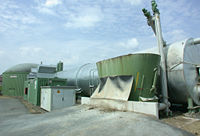
Photo from wikipedia
Fungal genome sequencing data represent an enormous pool of information for enzyme discovery. Here, we report a new approach to identify and quantitatively compare biomass-degrading capacity and diversity of fungal… Click to show full abstract
Fungal genome sequencing data represent an enormous pool of information for enzyme discovery. Here, we report a new approach to identify and quantitatively compare biomass-degrading capacity and diversity of fungal genomes via integrated function-family annotation of carbohydrate-active enzymes (CAZymes) encoded by the genomes. Based on analyses of 1932 fungal genomes the most potent hotspots of fungal biomass processing CAZymes are identified and ranked according to substrate degradation capacity. The analysis is achieved by a new bioinformatics approach, Conserved Unique Peptide Patterns (CUPP), providing for CAZyme-family annotation and robust prediction of molecular function followed by conversion of the CUPP output to lists of integrated “Function;Family” (e.g., EC 3.2.1.4;GH5) enzyme observations. An EC-function found in several protein families counts as different observations. Summing up such observations allows for ranking of all analyzed genome sequenced fungal species according to richness in CAZyme function diversity and degrading capacity. Identifying fungal CAZyme hotspots provides for identification of fungal species richest in cellulolytic, xylanolytic, pectinolytic, and lignin modifying enzymes. The fungal enzyme hotspots are found in fungi having very different lifestyle, ecology, physiology and substrate/host affinity. Surprisingly, most CAZyme hotspots are found in enzymatically understudied and unexploited species. In contrast, the most well-known fungal enzyme producers, from where many industrially exploited enzymes are derived, are ranking unexpectedly low. The results contribute to elucidating the evolution of fungal substrate-digestive CAZyme profiles, ecophysiology, and habitat adaptations, and expand the knowledge base for novel and improved biomass resource utilization.
Journal Title: Journal of Fungi
Year Published: 2021
Link to full text (if available)
Share on Social Media: Sign Up to like & get
recommendations!